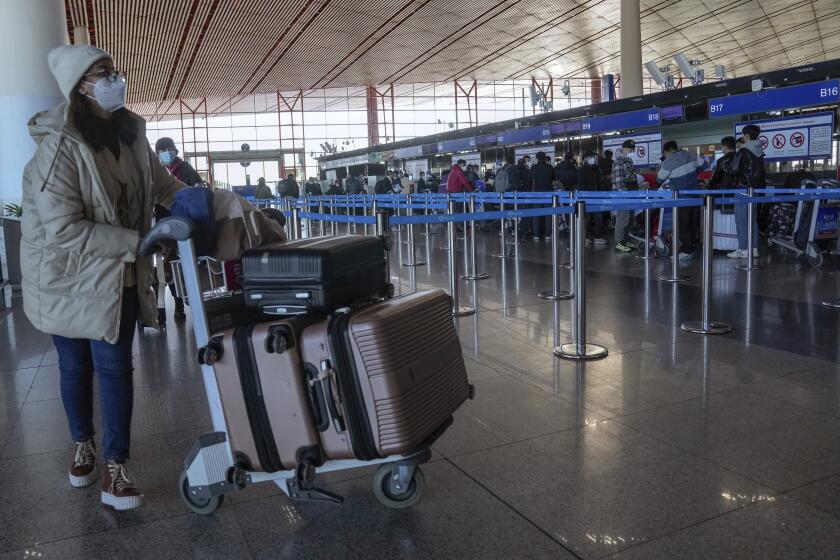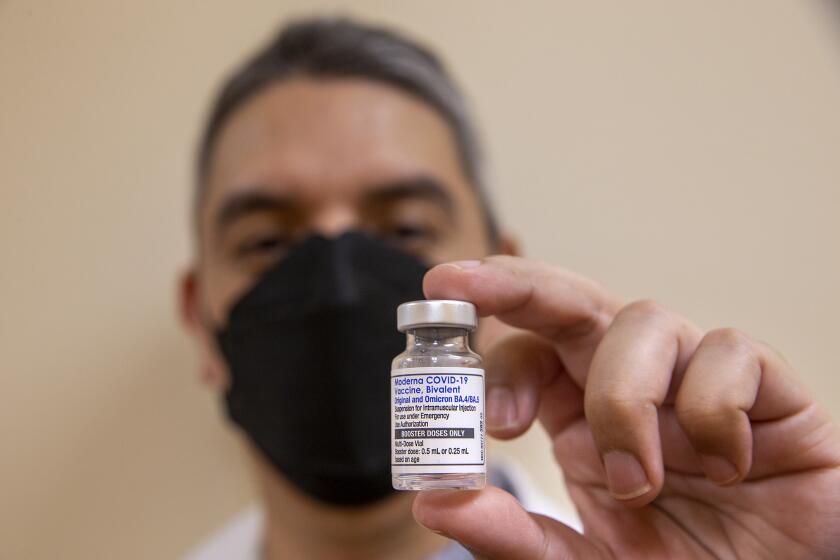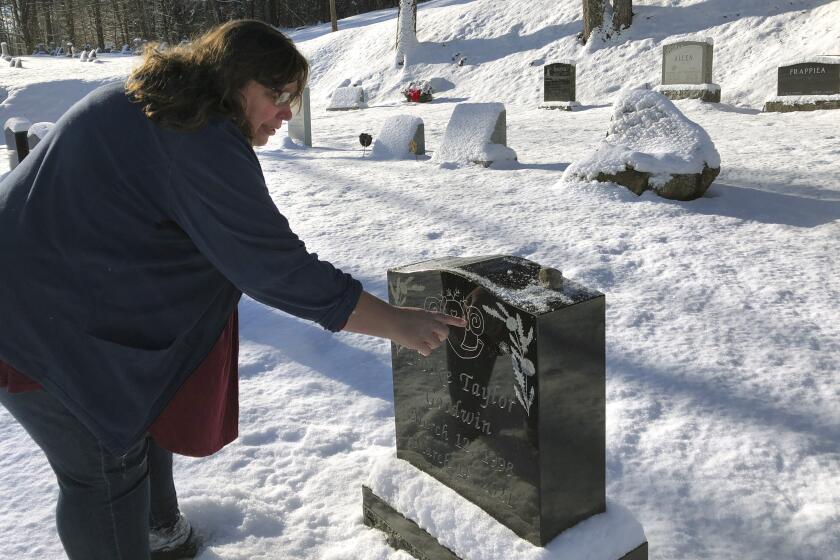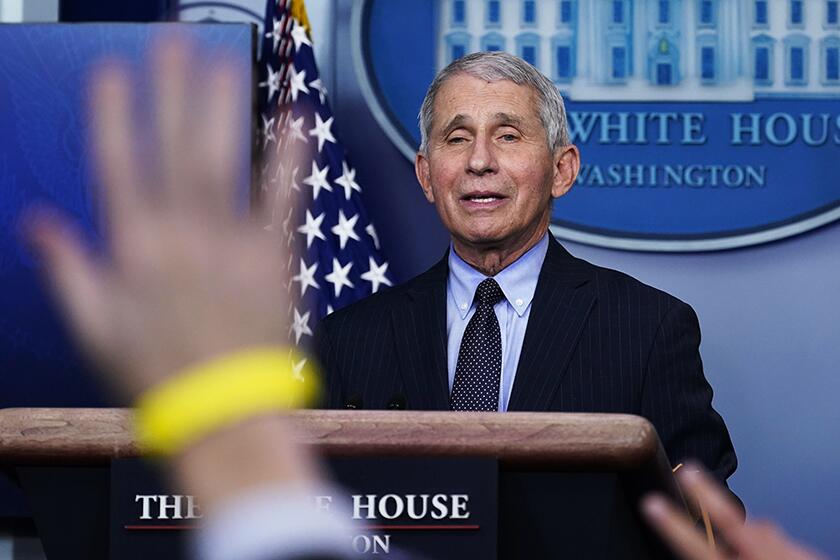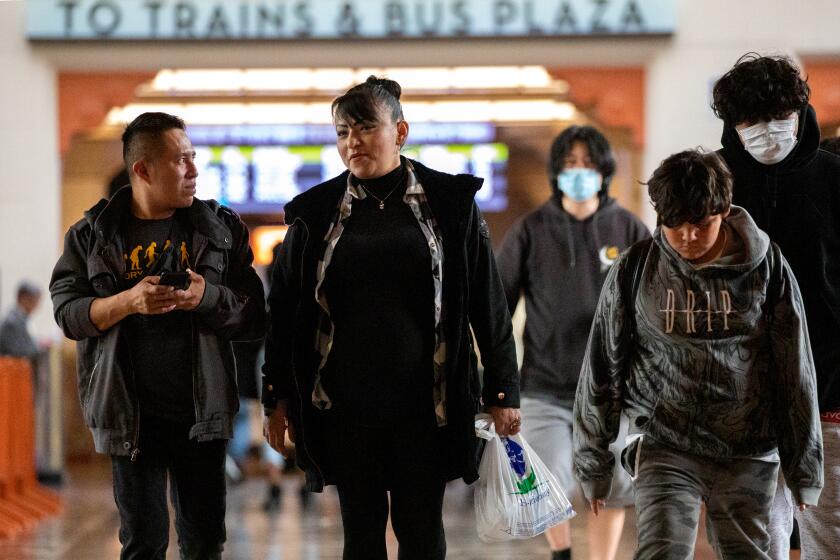Workers in L.A. County should wear masks indoors to prevent COVID surge, officials say

- Share via
Faced with the possibility of another COVID-19 surge stemming from parties and travel over the winter holiday season, Los Angeles County health officials are urging workers and students to wear masks in indoor public settings for at least 10 days once they return to work and school.
Wearing masks for this duration could help blunt another possible wave following New Year’s Day, officials say. Ten days is the rough incubation period for the coronavirus — the time between when someone is exposed and when they might be contagious, even if they don’t develop symptoms themselves.
“The holiday season by its very nature brings increased risk of exposure, including at celebrations and events, during travel or while out in more crowded public spaces,” L.A. County Public Health Director Barbara Ferrer said Thursday. “With transmission levels still high, there is a good likelihood many more people have been exposed.”
Masking, which remains recommended but not required in indoor public settings in L.A. County, can help interrupt the cycle of transmission, many experts say. Individual work sites, venues and other settings can set their own requirements if they so choose.
A statewide mask order remains in effect in healthcare settings and nursing homes. California workplace safety rules also require workers to mask up if they’ve been in close contact with an infected person for 10 days after the exposure.
Weekly COVID-19 deaths in Los Angeles County are the highest since late March, when the county was emerging from the initial winter Omicron wave.
School systems in L.A. County have not followed the path being pursued by their counterparts in Philadelphia, where the school district plans an indoor mask order for students and staff for the first eight days of school after winter break.
L.A. County health officials are, for the moment, expressing relative optimism about recent coronavirus trends. Case rates are continuing to decline following a Thanksgiving surge, and coronavirus levels in wastewater are also dropping as well — downturns that have greatly diminished the likelihood of a universal indoor mask mandate returning this winter.
Still, as has been proven time and again in the COVID-19 era, the nation’s most populous county does not exist in a vacuum. Developments and trends elsewhere have a way of making themselves felt locally one way or another.
Global concern grows that Beijing may be too slow to report new variants to the rest of world. Which, in turn, could lead to new outbreaks.
The pandemic’s previous waves have often coincided with the rise of a newer problematic version of the coronavirus, as happened last fall and winter with the arrival of the Omicron variant and the previous summer, when Delta fueled a surge in cases and hospitalizations.
This year has been defined by different subvariants of Omicron jockeying for nationwide supremacy. In recent months, the long-dominant BA.5 gave way to two of its own descendants, BQ.1 and BQ.1.1.
But those have been supplanted this month by the rapid rise of another subvariant, XBB.1.5, which now accounts for an estimated 40.5% of cases nationwide, according to data from the U.S. Centers for Disease Control and Prevention.
Two weeks ago, that particular strain was linked to only about 10% of new cases nationally. The rise has been particularly pronounced in the Northeast, and officials are investigating whether the new subvariant is causing a huge increase in case rates.
XBB.1.5 is a descendant of XBB, which itself is a recombinant of descendants of the Omicron subvariant BA.2.
In a blog post, Dr. Eric Topol, director of the Scripps Research Translational Institute in La Jolla, wrote that “New York is the bellwether for what is happening with XBB.1.5 and it doesn’t look good with a marked rise in hospitalizations, especially among seniors, in recent weeks as this variant has been taking hold.”
“Of course, other factors are likely contributing such as waning of immunity, indoor/holiday gatherings, cold weather, lack of mitigation,” he wrote.
New York City’s hospitalization rates are higher than L.A. County’s.
Chinese officials are going door to door and paying people older than 60 to get vaccinated against COVID, but many are concerned about side effects.
An explosive surge in China following the end of the nation’s “zero COVID” policy is also worrisome.
“When you have these huge increases in case numbers, it’s fertile ground for new mutations. And new mutations are scary for all of us,” Ferrer said.
L.A. County reported 2,359 coronavirus cases a day for the seven-day period that ended Friday, down 9% from the prior week. That’s still more than double the rate from the first week of November, but significantly less than the autumn peak of 3,929 cases a day, recorded during the first week of December.
On a per capita basis, L.A. County’s latest coronavirus case rate is 163 cases a week for every 100,000 residents. A rate of 100 or more is considered high.
The official coronavirus case rate only captures a fraction of the true number of infections, given that so many people are testing for the virus with at-home rapid tests — the result of which are not reliably reported to the government. Nonetheless, Ferrer said she’s “relieved that the trend line for cases is declining.”
COVID-19 hospitalizations are also no longer increasing in L.A. County, though they remain elevated. On Thursday, there were 1,249 coronavirus-positive patients in hospitals in L.A. County, more than double the levels seen in mid-November.
L.A. County recorded 113 COVID-19 deaths for the week that ended Friday, down 26% from the prior week.
This late December decline in cases marks a stark departure from the trend seen the last two years — when increases that began in late autumn ballooned continuously through the early winter, eventually leading to the two deadliest waves of the pandemic.
It remains to be seen whether this latest expansion of eligibility will lead to shots going into significantly more arms.
In December 2020, almost no one was vaccinated for COVID-19 as the inoculation campaign was in its initial, very limited stage. The following year saw the arrival of the wildly contagious Omicron variant, which went on to infect record numbers of people.
But compared to the last two Decembers, “we’ve got more powerful tools that are being used by more people” to protect themselves from COVID-19, Ferrer said.
Chief among those is an updated COVID-19 booster shot that is better matched to the Omicron subvariants now in circulation.
According to a recent study published by the CDC, the newer bivalent booster provided additional protection against COVID-associated emergency room or urgent care visits and hospitalizations compared to people who had only received the original vaccine formula.
U.S. life expectancy, already declining since the onset of the pandemic, fell further in 2021, according to the CDC’s final accounting of death certificates.
Unlike previous years, there’s also plentiful supply of treatments such as Paxlovid, an antiviral pill that was in severely short supply for months after the U.S. Food and Drug Administration authorized it a year ago.
More residents heeding the pleas from public health officials to take precautions — such as wearing masks in indoor public settings and staying home when they’re sick — could also be contributing to the recent dip. Other steps to prevent viral illness transmission include frequent handwashing, sanitizing high-touch surfaces and staying home when sick.
Ferrer said she’s hopeful that continued adherence to sensible precautions could help limit a second surge to start 2023.
“We’ve all had disruptions over the holiday season with family members and friends that have been sick,” she said. “And if it’s not with COVID, it’s with flu or it’s with some other really bad cold. So there’s just a lot of illness circulating around — a lot of respiratory viruses — and the masks really do help.”
Flu and respiratory syncytial virus, or RSV, have started to decline both nationally and in L.A. County, but remain at relatively high levels. In fact, the flu positivity rate in L.A. County is still at a higher figure than the peak of the 2018–19 season.
Dr. Anthony Fauci talks with us about his career, shares his tips to remain healthy during the tripledemic and reveals his favorite Jesuit saint
In a recent interview with The Times podcast, Dr. Anthony Fauci, President Biden’s outgoing chief medical advisor for the pandemic, said he’s “concerned that we might get complacent, because we’re not out of this yet.”
“The thing that’s most troubling to me is that we have a good updated booster … and yet only 14% of the eligible population in this country has actually received that. We’ve got to do much better than that,” Fauci said. And the U.S. is underutilizing anti-COVID drugs like Paxlovid, which are effective at reducing severe illness and death.
As we head into the fourth year of the pandemic, “our fate is in our own hands,” Fauci said. “If we do the appropriate public health measures to mitigate against any further surges, we should do fine. But that’s not going to happen spontaneously. We’ve got to go out and we’ve got to get vaccinated. We’ve got to get boosted.”
COVID-19 is still exacting a deadly toll that significantly outpaces that associated with flu. Nationally, about 33,000 U.S. COVID-19 deaths have been reported since early October, compared with 13,000 flu deaths. L.A. County estimates there have been about 360 flu deaths over the same time period, less than half of COVID-19’s confirmed toll of 764.
“The magnitude of devastation associated with COVID remains high,” Ferrer said. With only 20% of vaccinated L.A. County residents age 5 and up having received the updated booster, Ferrer urged 6 million eligible residents to get the new shot.
The coronavirus and the flu are surging in California. Here are the steps to protect yourself from getting sick during the holiday season.
Long COVID also remains a public health risk, with a certain percentage of COVID-19 survivors suffering from prolonged and persistent illness lasting long after the acute coronavirus infection has ended.
“Some of those symptoms could be troublesome but not totally incapacitating, like chronic fatigue, and inability to perform at the level that you were before,” Fauci said. “But in some unfortunate individuals, it can be really rather incapacitating. And there’s an estimate that about a million people in the United States have not been able to go back to work due to long COVID symptoms. ... You’re talking about a significant impact on public health.”
Times staff writer Gustavo Arellano contributed to this report.
More to Read
Sign up for Essential California
The most important California stories and recommendations in your inbox every morning.
You may occasionally receive promotional content from the Los Angeles Times.

